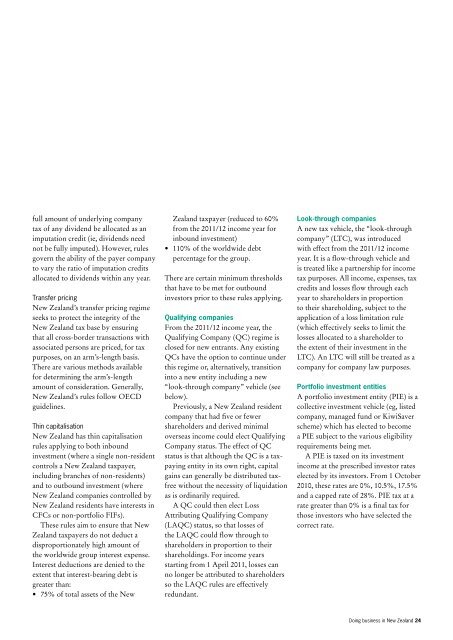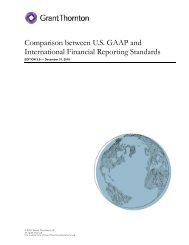Doing business in New Zealand - Grant Thornton
Doing business in New Zealand - Grant Thornton
Doing business in New Zealand - Grant Thornton
Create successful ePaper yourself
Turn your PDF publications into a flip-book with our unique Google optimized e-Paper software.
full amount of underly<strong>in</strong>g company<br />
tax of any dividend be allocated as an<br />
imputation credit (ie, dividends need<br />
not be fully imputed). However, rules<br />
govern the ability of the payer company<br />
to vary the ratio of imputation credits<br />
allocated to dividends with<strong>in</strong> any year.<br />
Transfer pric<strong>in</strong>g<br />
<strong>New</strong> <strong>Zealand</strong>’s transfer pric<strong>in</strong>g regime<br />
seeks to protect the <strong>in</strong>tegrity of the<br />
<strong>New</strong> <strong>Zealand</strong> tax base by ensur<strong>in</strong>g<br />
that all cross-border transactions with<br />
associated persons are priced, for tax<br />
purposes, on an arm’s-length basis.<br />
There are various methods available<br />
for determ<strong>in</strong><strong>in</strong>g the arm’s-length<br />
amount of consideration. Generally,<br />
<strong>New</strong> <strong>Zealand</strong>’s rules follow OECD<br />
guidel<strong>in</strong>es.<br />
Th<strong>in</strong> capitalisation<br />
<strong>New</strong> <strong>Zealand</strong> has th<strong>in</strong> capitalisation<br />
rules apply<strong>in</strong>g to both <strong>in</strong>bound<br />
<strong>in</strong>vestment (where a s<strong>in</strong>gle non-resident<br />
controls a <strong>New</strong> <strong>Zealand</strong> taxpayer,<br />
<strong>in</strong>clud<strong>in</strong>g branches of non-residents)<br />
and to outbound <strong>in</strong>vestment (where<br />
<strong>New</strong> <strong>Zealand</strong> companies controlled by<br />
<strong>New</strong> <strong>Zealand</strong> residents have <strong>in</strong>terests <strong>in</strong><br />
CFCs or non-portfolio FIFs).<br />
These rules aim to ensure that <strong>New</strong><br />
<strong>Zealand</strong> taxpayers do not deduct a<br />
disproportionately high amount of<br />
the worldwide group <strong>in</strong>terest expense.<br />
Interest deductions are denied to the<br />
extent that <strong>in</strong>terest-bear<strong>in</strong>g debt is<br />
greater than:<br />
• 75% of total assets of the <strong>New</strong><br />
<strong>Zealand</strong> taxpayer (reduced to 60%<br />
from the 2011/12 <strong>in</strong>come year for<br />
<strong>in</strong>bound <strong>in</strong>vestment)<br />
• 110% of the worldwide debt<br />
percentage for the group.<br />
There are certa<strong>in</strong> m<strong>in</strong>imum thresholds<br />
that have to be met for outbound<br />
<strong>in</strong>vestors prior to these rules apply<strong>in</strong>g.<br />
Qualify<strong>in</strong>g companies<br />
From the 2011/12 <strong>in</strong>come year, the<br />
Qualify<strong>in</strong>g Company (QC) regime is<br />
closed for new entrants. Any exist<strong>in</strong>g<br />
QCs have the option to cont<strong>in</strong>ue under<br />
this regime or, alternatively, transition<br />
<strong>in</strong>to a new entity <strong>in</strong>clud<strong>in</strong>g a new<br />
“look-through company” vehicle (see<br />
below).<br />
Previously, a <strong>New</strong> <strong>Zealand</strong> resident<br />
company that had five or fewer<br />
shareholders and derived m<strong>in</strong>imal<br />
overseas <strong>in</strong>come could elect Qualify<strong>in</strong>g<br />
Company status. The effect of QC<br />
status is that although the QC is a taxpay<strong>in</strong>g<br />
entity <strong>in</strong> its own right, capital<br />
ga<strong>in</strong>s can generally be distributed taxfree<br />
without the necessity of liquidation<br />
as is ord<strong>in</strong>arily required.<br />
A QC could then elect Loss<br />
Attribut<strong>in</strong>g Qualify<strong>in</strong>g Company<br />
(LAQC) status, so that losses of<br />
the LAQC could flow through to<br />
shareholders <strong>in</strong> proportion to their<br />
sharehold<strong>in</strong>gs. For <strong>in</strong>come years<br />
start<strong>in</strong>g from 1 April 2011, losses can<br />
no longer be attributed to shareholders<br />
so the LAQC rules are effectively<br />
redundant.<br />
Look-through companies<br />
A new tax vehicle, the “look-through<br />
company” (LTC), was <strong>in</strong>troduced<br />
with effect from the 2011/12 <strong>in</strong>come<br />
year. It is a flow-through vehicle and<br />
is treated like a partnership for <strong>in</strong>come<br />
tax purposes. All <strong>in</strong>come, expenses, tax<br />
credits and losses flow through each<br />
year to shareholders <strong>in</strong> proportion<br />
to their sharehold<strong>in</strong>g, subject to the<br />
application of a loss limitation rule<br />
(which effectively seeks to limit the<br />
losses allocated to a shareholder to<br />
the extent of their <strong>in</strong>vestment <strong>in</strong> the<br />
LTC). An LTC will still be treated as a<br />
company for company law purposes.<br />
Portfolio <strong>in</strong>vestment entities<br />
A portfolio <strong>in</strong>vestment entity (PIE) is a<br />
collective <strong>in</strong>vestment vehicle (eg, listed<br />
company, managed fund or KiwiSaver<br />
scheme) which has elected to become<br />
a PIE subject to the various eligibility<br />
requirements be<strong>in</strong>g met.<br />
A PIE is taxed on its <strong>in</strong>vestment<br />
<strong>in</strong>come at the prescribed <strong>in</strong>vestor rates<br />
elected by its <strong>in</strong>vestors. From 1 October<br />
2010, these rates are 0%, 10.5%, 17.5%<br />
and a capped rate of 28%. PIE tax at a<br />
rate greater than 0% is a f<strong>in</strong>al tax for<br />
those <strong>in</strong>vestors who have selected the<br />
correct rate.<br />
<strong>Do<strong>in</strong>g</strong> <strong>bus<strong>in</strong>ess</strong> <strong>in</strong> <strong>New</strong> <strong>Zealand</strong> 24
















